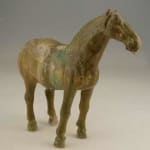Tang Glazed Sculpture of a Horse, 618 CE - 906 CE
Glazed Terracotta
height 20.6 cm
height 8 1/8 in
height 8 1/8 in
H.915
The great influence of the horse throughout the history of China cannot be underestimated. In fact, the expansion and maintenance of the Chinese Empire was due in large part to...
The great influence of the horse throughout the history of China cannot be underestimated. In fact, the expansion and maintenance of the Chinese Empire was due in large part to the rapid mobility of horses, enabling quick communication between far away provinces. Likewise, the military role of horses aided in the conquest and submission of distant lands. The need to import stronger, faster steeds from Central Asia (as opposed to the native Mongol pony) led to the establishment of the legendary Silk Road. The importance of the horse can be seen, in part, through the artistic legacy of this great civilization. In sculpture, painting, and literature, horses were glorified and revered, thought to be relatives of mythological dragons. During the Tang Dynasty, the adoration of the horse was embodied by their burial art. Sculptures of horses excavated from mausoleums of this period are among the most splendid and easily recognizable works of Chinese art. This elegant horse is a perfect example of the mastery of Tang funerary art. Coated in an earthy brown glaze with hints of green, this horse stands on all fours with its head slightly turned to the side as if investigated some distant rustling. The refined molding of this sculpture captures the power and grace of this majestic creature in its refined modeling and defined musculature. This elegant sculpture attests to the revered status of the horse while simultaneously revealing the artistic mastery of Tang sculptors.



